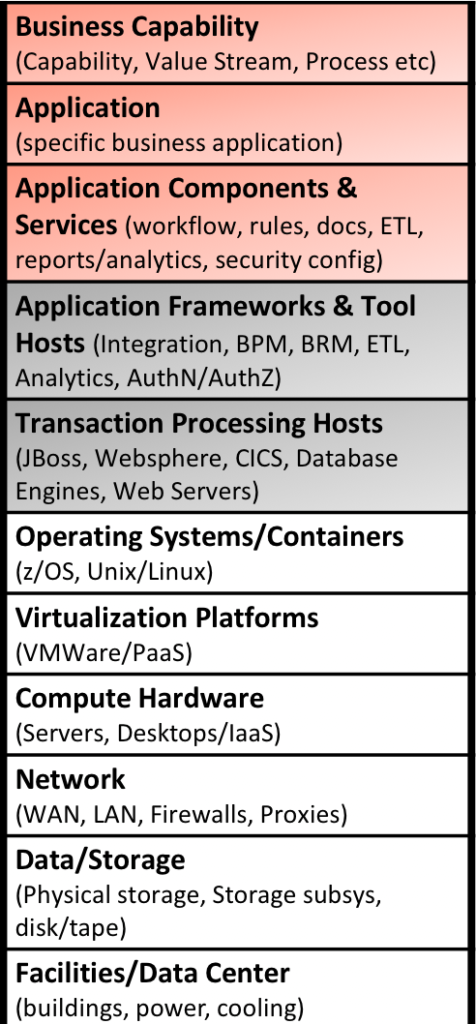Just how many layers are in Enterprise Information Technology Stack?1
Every framework that you come across has different ways of explaining the stacking or layering nature of Architecture, up to the point that you may think is there another way of looking at architecture. Archimate (although being part of The Open Group) suggests there are three layers, namely Business, Data, and Technology. The Open Group’s Architecture Framework suggests there are four layers, namely Business, Data/Information, Application, and Technology. If we look at the Zachman framework 2, we’ll find five layers, or six, or sometimes maybe more, or maybe less, depending on interpretation. Zachman considers layers somewhat differently from those in Archimate and TOGAF. Zachman layers are somewhat perspectives than layers but provide the correct dissection of Architecture to develop fidelity as we move deeper and/or horizontal.
Layers do not mean that Architecture is developed independent of each other and have nothing in common. The layers must be seen as filters on the overall architecture. The architecture that provides enough fidelity and lineage for developing a business suitable system. Layers are filters for the overall view of architecture, kind of a grouping of like artifacts to support the entire architecture for the focused view. Most of the Enterprise Architecture Frameworks are IT-centric, they are evolving to add more business focus for alignment to strategy.
EA3 Cube Framework3
Scott Bernard in his EA3 Cube Framework looks at stack differently, he suggests

The Organizing Influence of Enterprise Architecture
Enterprise Architecture = Strategy + Business + Technology
Scott Bernard visualizesEA as meta-discipline that covers entire organization, “EA is, therefore, THE architecture of the enterprise and should cover all elements and aspects. Having a single source of reference is essential to avoiding waste and duplication in large, complex organizations. It also resolves the “battle of best practices” and competition between sub-architectural domains which can be problematic for organizations that are trying to become for efficient.”
He further elaborates the EA at three different levels 1) Strategy Level, 2) Business Level, 3) Technology Level, whereas the stack contains 5 layers,
- Goals and Initiatives
- Products and Services
- Data and Information
- System and Application
- Network and Infrastructure
The architecture layers as mentioned above can be applicable to each business segment. A segment architecture is somewhat similar, but usually focuses one or more particular business units or functions – such as the finance and accounting group, or how a financial ERP system and all of its modules are going to be implemented (general ledger, accounts payable, accounts receivable, payroll, benefits, etc.).
What happened to Security and Integration Layers in the Stack? 4
The entire industry is moving to B-DAT model for Enterprise Stack. In the move, suddenly I am looking at several different EA frameworks that explain how to organize and use the Enterprise Information Technology Stack.

Enterprise Stack for Governance
Not sure when we lost track of important aspects of architecture namely Integration and Security. Remember, integration of systems was the most important thing, that gave rise to Enterprise Application Integration patterns, that included Enteprise Service Bus as well. Then the most important Security, what happened to security architecture as well?
References
- Tom, G, On layers in enterprise-architecture, http://weblog.tetradian.com/2013/12/11/on-layers-in-ea/
- Zachman Framework, http://www.zachman.com/about-the-zachman-framework
- Bernard, Scott, EA3 Cube Framework, https://eapad.dk/ea3-cube/overview/
- Survey of Architecture Frameworks, http://www.iso-architecture.org/42010/afs/frameworks-table.html
